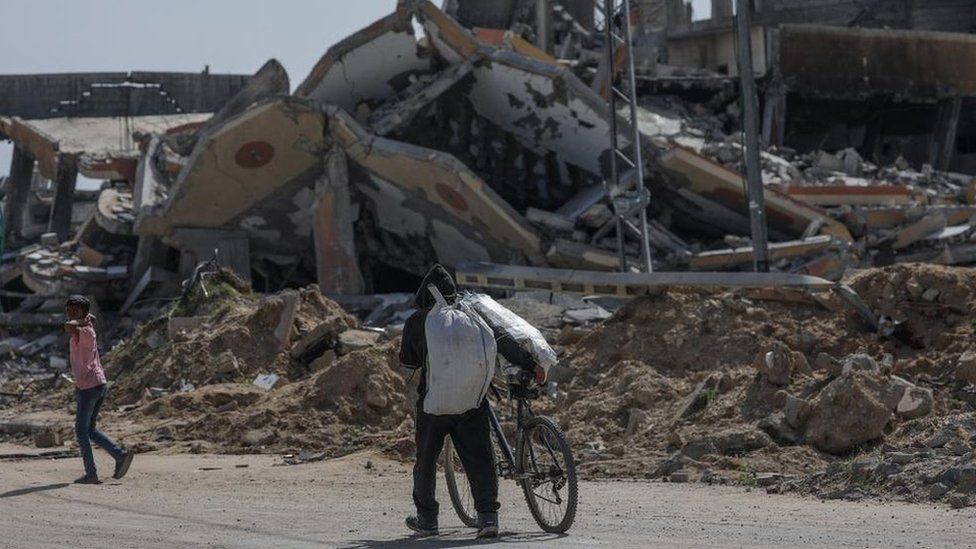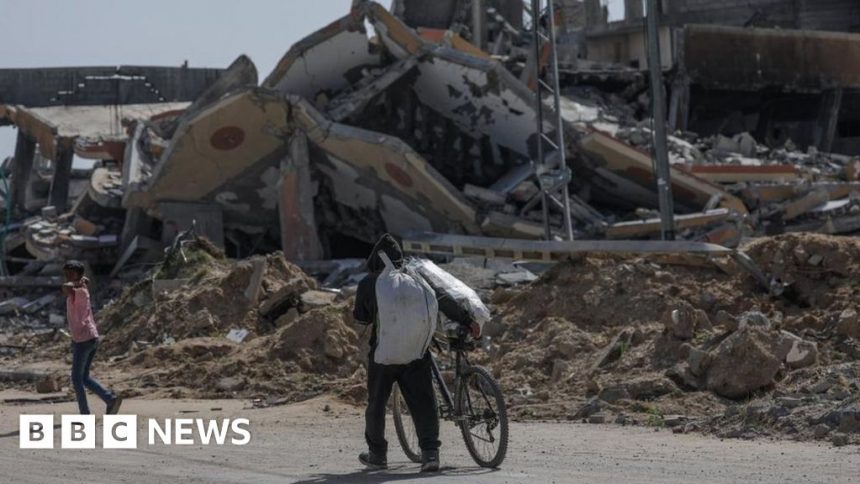Rafah: UN says 80,000 have fled Gaza city as Israeli strikes intensify
-
Published

More than 80,000 people have fled the southern Gaza city of Rafah since Monday, the UN says, as Israeli tanks reportedly mass close to built-up areas amid constant bombardment.
Palestinian armed groups said they were targeting Israeli troops to the east.
Israel’s military has said its ground forces are conducting “targeted activity” in eastern Rafah.
The UN also warned that food and fuel were running out because it was not receiving aid through nearby crossings.
Israeli troops took control and closed the Rafah crossing with Egypt at the start of their operation, while the UN said it was too dangerous for its staff and lorries to reach the reopened Kerem Shalom crossing with Israel.
It came a day after the US warned that it would stop supplying Israel with some weapons if it launched a major assault on “population centres” in Rafah.
After seven months of war in Gaza, Israel has insisted victory is impossible without taking the city and eliminating the last remaining Hamas battalions.
But with more than a million displaced Palestinians sheltering there, the UN and Western powers have warned that an all-out assault could lead to mass civilian casualties and a humanitarian catastrophe.
Residents and aid workers in Rafah said the sound of artillery and air strikes was constant on Thursday.
Louise Wateridge, a spokeswoman for the UN aid agency for Palestinian refugees (UNRWA), told the BBC in the afternoon that she was at a health facility in the west and could “hear and feel the bombardment coming closer”.
“The building is shaking on a frequent basis. There is this constant buzzing of drones,” she said. “The fear and nervousness that people [in Rafah] have had, has now become terror.”
Palestinian media said two people were killed on Thursday afternoon in an Israeli air strike in the al-Jneineh neighbourhood – one of the eastern areas which the Israel Defense Forces (IDF) ordered residents to evacuate before beginning its ground operation began on Monday night.
Another three people were reportedly killed in an air strike in the nearby Brazil neighbourhood, which is not in the evacuation zone but is next to the Egyptian border and about 2.5km (1.5 miles) north of the Rafah crossing.
Hamas and Palestinian Islamic Jihad (PIJ) – which are proscribed as terrorist organisations by Israel, the US and other countries – said they were targeting Israeli forces on the eastern outskirts with mortars and anti-tank missiles.
Hamas also said it had blown up a booby-trapped tunnel east of Rafah underneath three Israeli military vehicles. The IDF said three of its soldiers were moderately wounded as a result of the explosion.
Overnight, at least five people were reportedly killed when a family’s home in the western Tal al-Sultan neighbourhood was hit in an Israeli strike. They included three children, one of them a one-year-old infant, medics said.
The IDF said on Wednesday evening that soldiers had been carrying out “targeted operations on the terrorist infrastructure surrounding the Gazan side of the Rafah crossing and conducted operational raids on suspicious buildings in the area”, and that about 30 “terrorists” had been eliminated. It also said Israeli aircraft had struck targets in support of the troops.
The director of the Kuwaiti Specialist Hospital in central Rafah – one of only two hospitals still partially functioning in the city – told BBC Arabic on Thursday that it was facing a surge in casualties, including many “unusual injuries caused by unusual weapons”.
“We have received some cases of torn abdomen and intestines, and cases of skull fractures with parts of the brain outside the skull,” Dr Jamal al-Hams said. “Some cases have lost major parts of the buttocks, in addition to cases of amputation of the lower limbs at the foot.”
“I lived through all previous wars [in Gaza]… where injuries were always in a certain area and dealt with by one specialist. But now each case needs several specialists.”
But he added: “Unfortunately, the Kuwaiti hospital is a small hospital that does not have diagnostic capabilities – even the X-ray machine is disabled due to Israeli shelling and there are no spare parts for it.”
Dr Hams said the situation had been made worse by the closure of the al-Najjar hospital in the city’s east on Wednesday due to an evacuation order and nearby fighting.
“Residents were also ordered [by the Israeli military] to evacuate their homes and the doctors, like any other human beings, are looking for shelter for their families,” Dr Hams added.
“But where should they go? Tents and other supplies were supposed to be provided in other safe areas. This has not been done.”
The IDF has told displaced people to head towards an “expanded humanitarian area” stretching from nearby al-Mawasi to the city of Khan Younis and central town of Deir al-Balah. It said they would find field hospitals, tents and additional aid supplies.
However, Palestinians and UN officials said it was made up of neighbourhoods that were already overcrowded and lacking in essential services, were still coming under bombardment, or had been left in ruins by recent fighting.
Unrwa’s deputy director in Gaza, Scott Anderson, told the BBC that the agency had seen a “significant movement of population, with over 80,000 people now displaced” as the fighting moved “further westward to the centre of Rafah itself”.
“But perhaps most worrying, because [the] Rafah and Kerem Shalom entry points are closed, we are beginning to run out of fuel that enables us to provide the response to the people who are being displaced, as well as the other people in Gaza,” he added.
The World Health Organization also warned that hospitals in southern Gaza – including those outside Rafah – only had a three days of fuel left. Fuel is also needed to power water pumps and sewage treatment plants.
On Wednesday, the Israeli military announced it had reopened the Kerem Shalom crossing, a key aid entry point that had been closed for four days because of a Hamas rocket fire.
It released a video showing aid lorries being unloaded, but the UN said the fighting made it impossible for its staff and lorries to pick up supplies.
“The challenge is one of security. The combat operations are very focused in the south-east part of Rafah. There is a very large IDF presence. There seems to be a very large militant presence as well,” Mr Anderson said.
“We’re concerned about our ability to move staff and trucks safely in and out of the crossing to bring in humanitarian aid.”
In response, the IDF said it took “all operationally feasible measures to mitigate harm to civilians, including aid convoys and workers. The IDF has never, and will never, deliberately target aid convoys and workers.”
It added: “The IDF makes extensive efforts to enable the safe delivery of humanitarian aid, and has been working closely with various aid groups to co-ordinate and realise their vital efforts to provide food and humanitarian aid.”
Meanwhile, indirect talks in Cairo on a ceasefire and hostage release deal appeared to once again grind to a halt on Thursday, with both the Israeli and Hamas delegations leaving.
Israel launched a military campaign in Gaza to destroy Hamas in response to the group’s cross-border attack on southern Israel on 7 October, during which about 1,200 people were killed and 252 others were taken hostage.
More than 34,900 people have been killed in Gaza since then, according to the territory’s Hamas-run health ministry.




